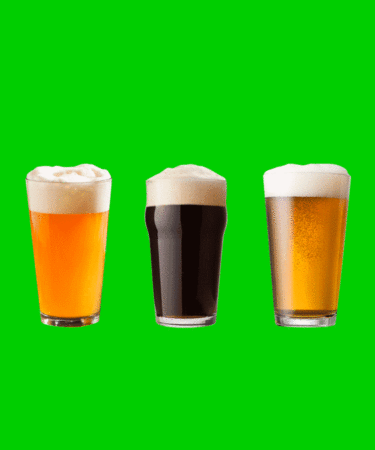The world of beer can be overwhelming and confusing. We all have our go-to brews, from basic brands like Bud Light or Coors — both macro lagers — to locally brewed IPAs on tap. But what do these terms actually mean, and how do they differ?
Beer has existed around the world for millennia, resulting in an explosion of varieties and types pertaining to local ingredients and consumer tastes. Its evolution is evident in titles such as “Belgian pale ales,” “Japanese rice lagers,” and “American blonde ales.” However, while many countries boast local delicacies, the brewing process remains relatively the same regardless of where it’s made.
There are four ingredients that must be used to make almost any beer style: water, malt, hops, and yeast. By controlling the amounts and types of grain, hops, yeast, and water chemistry — along with any additional ingredients, also known as adjuncts — brewers are allowing for different flavors, colors, alcohol levels, and textures to come out in the final fermented product.
Table Of Contents
The Two Main Types of Beer
An important thing to note is the difference between the two main types of beer — ales and lagers. These are the two most basic classifications of beer types that occur during fermentation, where ale is defined by top-fermenting yeasts that convert sugars into alcohol and carbon dioxide at higher temperatures, while lagers are defined as bottom-fermented with yeast that sinks to the bottom of the fermentation vessel and that do their work better at lower temperatures.
The rest — bitter, sweet, light, boozy — is up to the discretion of brewers. It’s a lot of information to take in, as with the history of beer itself. But without further ado, here are the most popular beers found around the world today, and what distinguishes them from the rest.
Ale Styles
Often regarded as a “starter beer,” American blonde ale contains relatively low levels of hops and malt with less alcohol than an average ale. Hints of sweet, citrusy flavors are reminiscent of lemonade, resulting in a refreshing beer on a hot afternoon or to get your drinking at the bar started.
This true American beer existed to compete with the German lager. The process of making American cream ale is inspired by aspects of lager brewing, which includes storing yeast and grains to create a moderately hoppy, malty beer most beloved in the Northeast and Midwest.
American wheat ale is a large category encompassing any beer in which a proportion of wheat is added to the grist before brewing. A cousin of German weissbier and Belgian witbier, American wheat ales come in a variety of forms, including pale and dark.
Despite its name, barleywine is not in fact wine, but a strong beer made with barley, that is rich in flavor and texture, and fermented to higher alcohol levels. Barleywine was first brewed in England, where the malty complexion and sweet, fruity flavors balance out a high alcohol content. In America, barleywine is hoppier though not as hop-extreme as a double IPA, with bitterness and citrusy notes.
Types of Belgian Beers
The world of Belgian beer is rich in process, flavor, and history. Monks have been brewing beer for centuries here, allowing for a variety of styles to emerge over time. It’s difficult to define these loose varieties, but many look at how much malt and yeast are added to the original recipes used by Monks since the early 19th century.
- Dubbel beers are usually twice as strong as classic Belgian beers (thus “dubbel” or “double”) and tend to have high alcohol content with a deep, rich flavor stemming from candi sugar used during the brewing process. These beers often lack strong hops and bitterness, so they get their flavors from malt and yeast allowing for fruity esters to emerge.
- Further up the rung of Belgian beer strength, tripel is brewed with a light pilsner malt with a golden complexion. The name “tripel” comes from the amount of malt used during the brewing process — nearly three times the normal amount of classic Belgian beers. This beer variety tends to be high in alcohol and offers flavors ranging from spicy, sweet, fruity, and citrusy.
- This subcategory of Belgian dark ales is strong, with alcohol content well into the double digits. Belgian quadruples (or “quads”) are maltier, with a spicy yeast profile. Though they give off hints of dark fruit, molasses, and peppery spice, Belgian quadrupels are not made using fruits or spices — nor are they for the faint of heart.
Belgian dark ale is often a good first endeavor into Belgian beer. They are amber to beep brown in color, defined by a higher alcohol content, but are balanced with yeast-driven spice and medium body. Dark ales’ bigger sibling, Belgian strong dark ale, possesses a richer flavor and higher alcohol content. They range in malts and hops and can be spicy or fruity, but the final flavor that emerges is rich and complex.
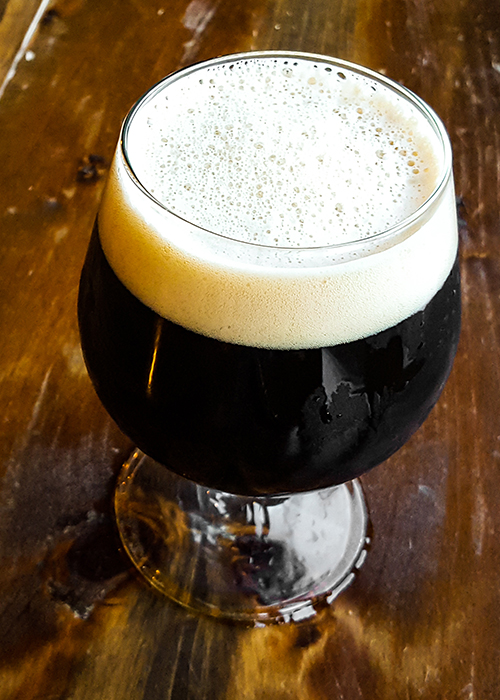
Belgian pale ale is golden in color and gets its lightly sweet flavors from pilsner malts. There is a large presence of hops with earthy tones that lead to a dry finish. Belgian strong pale ale is similar in make, but with a more refined hop flavor and less sweetness. This beer is still light in color, and offers fruity, spicy flavors.
Bière de Garde originates in France, and translates to “beer for keeping.” The style is brewed year-round, though stronger in the winter than in the summer. Flavors derive from natural environments and labels are based on the color of the brew (blond, amber, or brown).
As opposed to other pale ales, brown ale is maltier and toaster in flavor. The nutty, chocolaty notes are more prominent than fruity flavors from malt or hops. There are various ways to make brown ales, with differences occurring between English and American beers.
- English brown ale contains high levels of malt and low hops. These can be dry or sweet, depending on how the beer is brewed. The flavors are simple and homey, including biscuit, and toffee — the perfect afternoon on a rainy day. Inspired by the former, American brown ale is malt-forward but showcases a higher profile of hops. These are slightly bitter, with toasty chocolate and caramel flavors.
Much like cream ale, California common is considered to be a true “American” beer. It’s refreshing and fruity, with earthy tones and bitterness from the hops. Made during the Gold Rush generation, California commonly uses more yeasts to ferment at the coldest level. Also like cream ale, California common is brewed with lager yeast and fermented at ale temperatures, making it a “hybrid” beer style.
English milds can come in dark or pale form, which refers to the level of hops content. Pale milds showcase a malty composition, with slight hoppy bitterness and fruity flavors. A dark mild also has low hops, but contains higher amounts of malt for a fuller body. Meanwhile, the English bitter — despite its name — is not solely (nor very) bitter, but contains floral, earthy hops not often associated with American IPAs. Malt and hops are balanced to produce pronounced flavors.
Deriving its name from its Belgian birthplace, Flemish red ale features complex fruit flavors like cherries and oranges. But there are also oaky hints in this beer, which closely resembles wine.
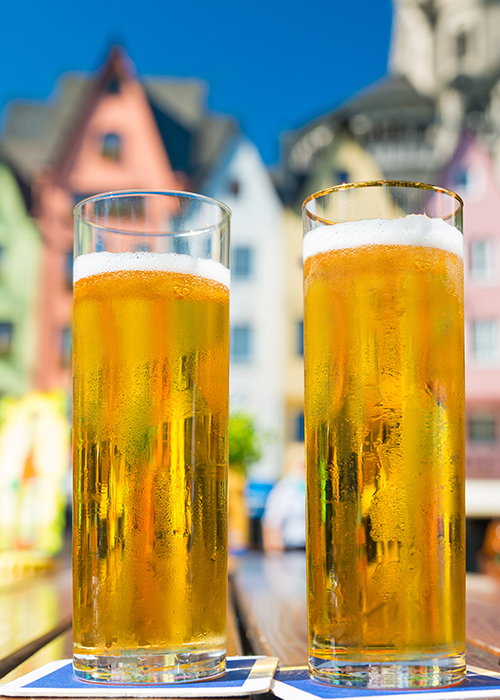
Another hybrid beer style, Kölsch derives from a combination of ale and lager fermentation techniques. These brews are light, with a delicate mix of malt and hops and slightly tart fruitiness. A dry finish lends itself to a refreshment beverage similar to a pilsner.
Much like India pale ale (IPA), pale ale is prevalent within the beer world. But rather than color — as the name would presume — these beers are defined by balanced maltiness and moderate hoppiness that lends itself to bitter flavors.
Pumpkin ale has risen in popularity in recent years. These beers are brewed with pumpkin, or more commonly puree and seasonal spices.
American red ale is made with caramel malt that creates a rustic, red hue and slightly sweet flavor but with bold hop bitterness. The flavor and color of American amber ale are slightly softer, with focus on the malts and fruity/caramel notes.
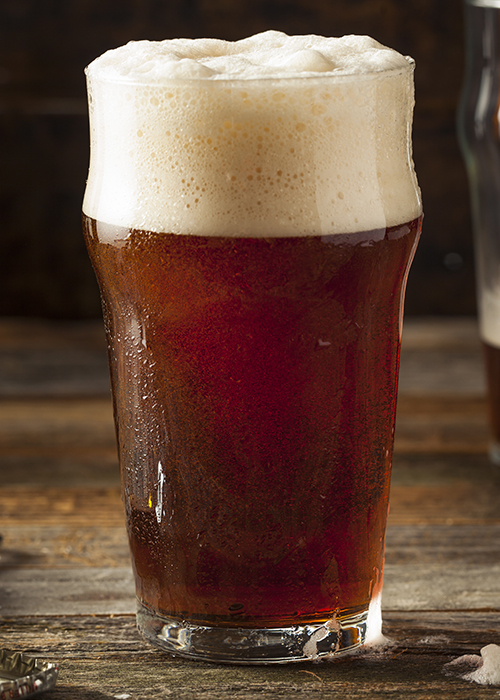
For Irish red ale, malt content is the focus. With minimal hops, the presence of sweet notes (toast, caramel, buttery toffee) come through, but end with a dry finish.
Rye beer isn’t a style as much as an emphasis on the ingredient found within; rye grain is used to replace a portion of the malt bill that goes into making beer and results in spicy characteristics and notable graininess.
- Roggenbier is brewed with special weizen yeasts (like dunkelweizen) that create banana/clove character. Roggenbier is sweet from the malt and spicy from rye, leaving a taste similar to pumpernickel bread.
- American rye beer is the U.S. variation of roggenbier. These beers display the classic “rye” flavors of grain and spice, and balance sourness with sweet malts. These contain hints of pine and citrus, slight hoppy bitterness — and can be made into a bold-tasting Rye IPA (or “Rye-PA”). Rye IPA mixes rye grain to malt, resulting in hoppy notes as well as citrusy, piney flavors. This subcategory of IPA is great for a strong drink at the end of the day.
Types of IPAs
You’ve probably heard of India pale ale (IPA) within the beer world countless times. It’s more of an umbrella term for a collection of craft beers that rely today on an abundance of hops for bitter, earthy, and fruity flavors.
- Think of American IPA in terms of East Coast style and West Coast style. West Coast IPAs are brewed with large amounts of hops and are engineered to result in powerful bitter flavors. East Coast IPAs possess stronger malt compositions and are often sweeter. New England IPA (NEIPA) is a sub-style of East Coast IPA. NEIPA is famous for beers with softer mouthfeel, sweeter profiles, and hop-driven tropical fruit flavors.
- Similar to American IPA, Belgian IPA is made with malted barley but uses a Belgian yeast strain during fermentation. These possess bitter flavors, which work alongside the malty complexion.
- Perhaps the first of the IPAs, the English IPA variety provides a balance between malt and hop flavors, so bitterness works alongside toasty and bready notes.
- Imperial beers such as “double IPAs” are higher-ABV and, in the case of IPA, strong hoppy beers. Extra hops and malt are added for a dominating final product, with the addition of fruity, earthy flavors and alcohol content. The key here are the hops, and they are prevalent.
- Roasted malt amplifies bitter hops in a black IPA. Chocolate and coffee flavors emerge, though these aren’t usually sweet. Rather, the dark malt notes lend to an overall stronger flavor.
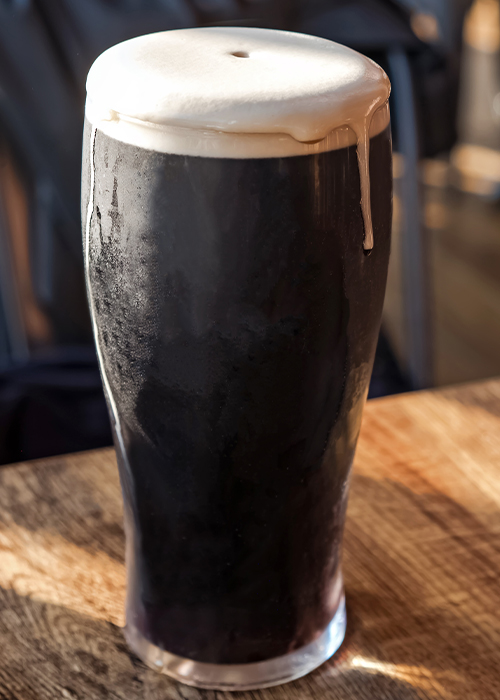
Types of Porters
A Porter is at the darker end of the beer spectrum, and comes in many forms.
- An English porter is brewed to be brown or robust; the former are malty with bittersweet flavors like chocolate, caramel, or toffee. Robust porters are intense and use roasted or black malt in a style that’s similar to a stout.
- Similar to English porters, Baltic porters contain complex flavors including molasses, chocolate, licorice, and toffee. While the roast does not reach the classic, dark porter flavor, Baltic Porters are defined by high ABVs and fruity esters.
- A leader of first-wave craft brews, American Porter uses smoky malts and intense hops inspired by English porters (but with a darker color and higher ABV).
A seasonal beer in its origin, saison (meaning “season” in French) was historically brewed toward the end of winter and enjoyed during the warmer summer months. The same wild yeast used in lambic creates sour, fruity flavors with earthy hops and a light malt. The result has a dry, spicy finish. Also known as “hoppy farmhouse ale,” saison is now consumed year-round.
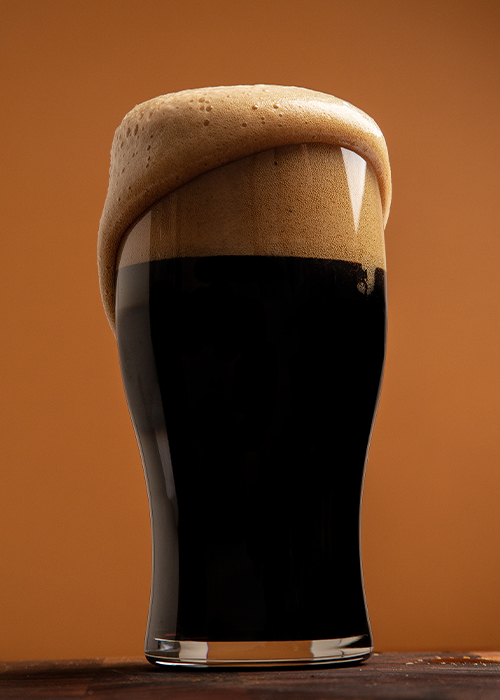
Types of Stouts
Stouts come in a range of variations, but these beers all possess a black complexion and are basically a stronger porter. Think: Guinness.
- An Irish stout is usually dry, with roasted barley taking center stage — along with flavors of chocolate, coffee, or toffee.
- In an English stout, roasted barley is used to create a dark roast flavor profile, and hops are used leading to a balance of malt and bitterness.
- No two American stouts are brewed the same way, but these all encompass roasted malt in one form or another. Flavors, hops, and alcohol content vary, allowing sweet and bitter flavors to emerge.
- Emerging in the 1800s, Russian imperial stouts boast high alcohol contents and intense flavor profiles of dark, roasty but fruity notes. These should be consumed slowly as they are quite intense.
- An American take on the Russian imperial stout, American imperial stout results in intense roasty flavors with some residual sweetness — and a noticeably high alcohol content.
- As the name would suggest, oats are added to mash during the brewing process for oatmeal stout, resulting in a malty sweetness and silky texture.
- Also known as sweet stout, milk stout beers are sweet thanks to lactose, a milk-derived sugar used during fermentation. Milk stout’s flavors tend to be roasty with low bitterness, with chocolate and coffee notes reminiscent of a boozy rich dessert.
- The oyster stout emerged in England in the early 1900s, as bar-goers would slurp oysters from the shell and use the brine during the brewing process. While there is not an official category for it, this style is still brewed today combining the bitter flavors of a stout with the briny salinity of an oyster shell.
Translated in Dutch to “white beer,” witbier tends to have a milky appearance. By law, this classic Belgian brew must consist of 50 percent of un-malted wheat, leaving it with a light grainy sweetness. Coriander and orange peel are also added, resulting in a citrusy, spicy beer with low hops and a smooth finish.
Berliner weiss is fermented with yeast and microbes that result in a sour, lightly malted beer. While brewers adjust the taste to local liking, the beer is defined by this sour taste and fruity flavors.
Weissbier (weizenbier) is a category of German wheat beers similar to American wheat ales and Belgian witbiers. But what sets these ales apart are the special yeast strains used during brewing, allowing for unique flavors across a variety of types.
- Hefeweizen contains high ratios of wheat and yeast that create a cloudy appearance. Hefeweizens are more malty than they are hoppy, with banana notes and low bitterness.
- Kristalweizen results from filtering the yeast out of hefeweizen, resulting in distinctive flavors and a crisp finish.
- “Dunkel” means dark, and dunkelweizen is just a darker wheat beer variety of hefeweizen with specialty roasted grain added There are notes of banana and clove, and the addition of dark malt brings out hints of caramel and rich complexion.
- In weizenbock, alcohol content is high, and while still brewed with the classic weissbier yeast, these have a rich body and maltier flavors (as opposed to hoppy bitterness).
The Wild/Sour varieties come in many forms, and are some of the oldest brewed beers, dating back centuries.
- Any American sour or American wild ale often takes the shape and style of the region it’s brewed in. For the most part, these beers are fermented with greater amounts of yeast and Pediococcus bacteria. The process can be done carefully, selecting the best microbes, or can ferment in open tanks with “wild” yeast from the air. Either way, the notes of sourness and acidic fruits emerge along with hints of oak if aged in barrels that lead to varying and satisfying hop and malt levels.
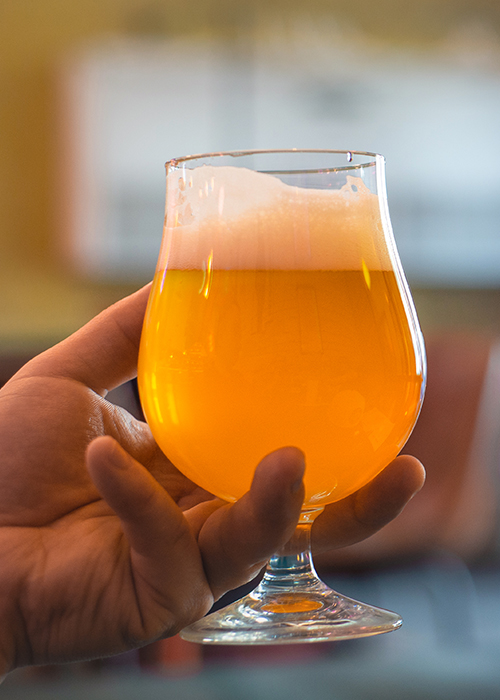
- Gose is an ancient beer style recently revived by craft beer, made with 50 percent malted wheat and the same fermented yeast used in wild and sour beers. The resulting sour, salty flavors are both lip-puckering and refreshing.
- Lambic is a Belgian beer category of its own, defined by an overwhelming sour taste. Unblended lambics are the result of spontaneous fermentation that allows for complex fruity notes, marked by sour flavors. In fruit lambic, fruits like cherries, raspberries, and peaches are used to counteract the otherwise sour flavors.
- Gueuze is a blend of young and old lambics, aged even longer for a sour, acidic flavor. This is balanced with malt and a slight oaky note from the cask it’s fermented in.
Lager Styles
It’s not a stout or a porter, but a black lager often resembles these beers. What distinguishes this category from others is the yeast fermentation. The lager contains roasty dark notes and high counts of hops that leave a pleasant bitterness.
A centuries-old beer style first made in Germany as an ale, bock over time became a lager upon the introduction of new yeast to the region. Bock is a strong beer, with malty, robust flavors and lingering sweetness.
- Considered one of the most “power-packing” lager beers, doppelbock is like its singular counterpart with a more powerful strength and flavor. These can be pale or dark, with a greater concentration of malt compared to hops. This leads to sweet, deep flavors of toast, caramel, toffee, raisins, and chocolate.
- As opposed to the previous variety, Maibock is a lighter bock made with pilsner malt traditionally brewed in May (hence “Mai”). The presence of bitterness from hops come through, and malt provides an overall toasty, bready feel.
- Eisbocks are defined by their high alcohol content, flavor, and unique process. Translating to “ice bock,” beer is frozen until the water within the distillation process begins to freeze. When the ice is removed, the resulting brew is strong and malty.
Japanese Rice Lager is made with malted barley and rice, resulting in a light-colored beer with sweet flavors balanced by subtle hoppy hints.
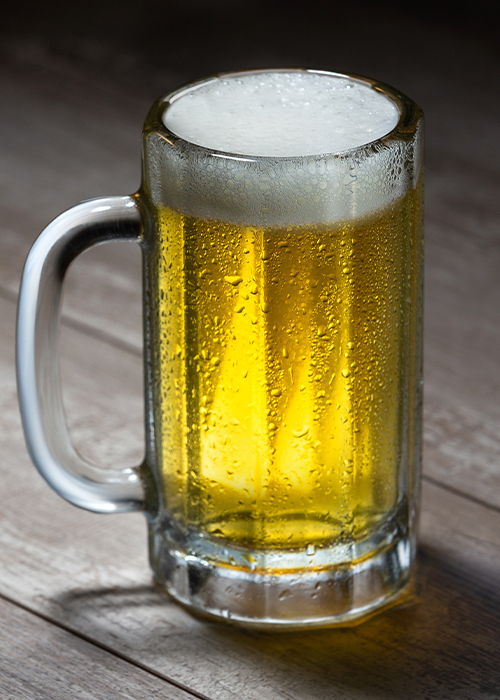
American lager is crisp with malt-forward flavors. When considering a macro lager, think: Budweiser, Coors, and Miller. These giants in the beer industry offer crisp, clean flavor profiles, brewed with some amount of corn or rice to lighten the flavors. A lower-calorie option, light American lager has the same clean, crisp flavors but with fewer calories, perfect for a refreshing barbecue beverage.
Originating in Munich, Germany, Munich dunkel lager is made with a large quantity of malt. This beer emphasizes rich, toasty, chocolaty flavors.
A Munich helles lager is light in color, derived from light malt and hops that provide supporting flavor. Similar to the pilsner in style, these beers are smooth, with a slightly higher alcohol content.
A staple at modern Oktoberfests particularly in the U.S. Märzenbiers (also known as simply Oktoberfest beers, though they are technically different beer styles) have a rich history dedicated to storing beers brewed mostly notable in March until the cold weather arrives. As such, they are matly and rich in flavor but light in body, with toasty hints and a lightly sweet finish perfect for the famous fall festival.
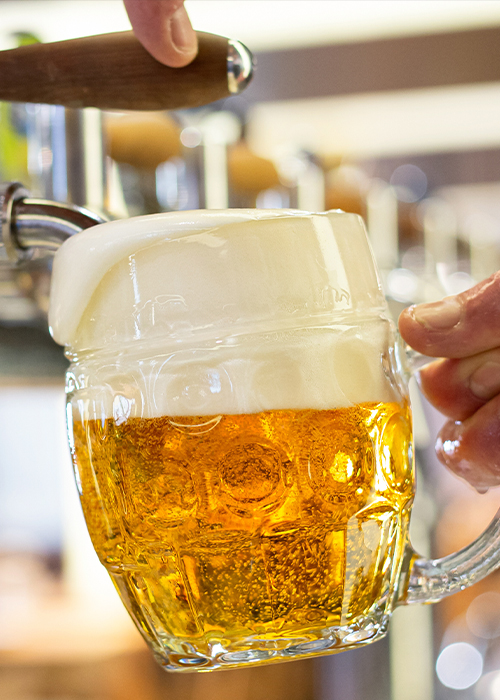
Founded in Pilsen, a small region of Czechia, a pilsner can be found around the world and in varying styles. Other forms exist around the world including American and German pilsners. While they are similar, each variety uses differing amounts of hops and malts resulting in bitterness levels and sweetness.
Session beer is low in alcohol (anywhere from 2.8 percent to 5 percent) and was consumed by British workers during World War I. They can be ales or lagers, and are closely associated with strong IPAs. With a nice combination of malts and hops, session beers are refreshing and cause for any relaxing gathering.
As its name suggests, rauchbier (smoked beer) is known to be exceptionally smoky. This is one of the only styles still drying grains near fire, resulting in woody or even bacony tastes.
